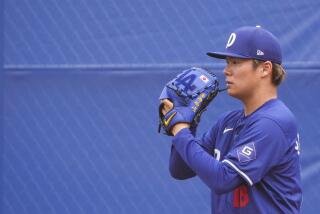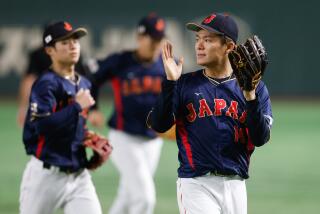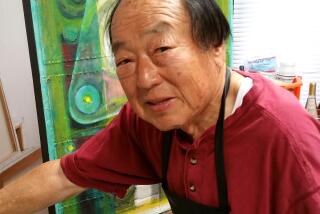Nakata Still on Learning Curve
SEOUL — It’s an older Hidetoshi Nakata who comes into this World Cup, but is he any wiser?
Certainly, Japan’s best known, highest paid and potentially most influential soccer player has had lessons aplenty since he sprang onto the international stage at the France ’98 World Cup.
What he learned in that time is vital to Japan’s chances of advancing to the second round from a modest group that includes Belgium, Russia and Tunisia.
Before the ’98 World Cup, England’s World Soccer magazine talked about Nakata’s “excellent vision, dribbling and possession skills, rounded off with bold, well-timed passes” and described him as “the joker who brings out the best in his teammates.”
Well, then 21-year-old Nakata and his teammates did not fare too well in their initial World Cup foray. They were ousted in the first round after single-goal losses to Argentina, Croatia and Jamaica.
It was a humbling experience for Nakata, even though his own performance led to a second consecutive Asian player of the year award.
More important, his play--not to mention the shock of his dyed-red hair--caught the eye of several European clubs. In the end, it was Perugia that splashed out $3.5 million to bring him to Italy from Bellmare Hiratsuka of Japan’s J-League.
Nakata flourished in Italy’s Serie A. It did not hurt his cause when he scored twice against Juventus in his debut for Perugia, and his stock continued to rise so that by January 2000 Perugia was able to realize a healthy profit on the midfielder when it sold him to AS Roma for $16 million.
The year 2000 marked the beginning of tougher times for the player known as “Hide,” whose rebellious outlook and rock-star dress style had made him the idol of millions of young Japanese. One indication of his popularity is his Web site, which receives more than 1 million hits a day.
At Roma, however, life became more complicated, not the least because there already was someone occupying Nakata’s midfield playmaking position--Italian national team standout Francesco Totti. Japan’s idol found himself on the bench.
Then there was his relationship with Philippe Troussier, Japan’s no-nonsense French coach. It was prickly at the best of times because of the distance separating them. Troussier was in Japan trying to build a team that could avoid the embarrassment of becoming the first host nation not to reach the second round of the World Cup. His star player, meanwhile, was concentrating on a career in Europe.
“I don’t know him,” Troussier told World Soccer earlier this year. “He comes back just one day before each [national team] match. I think Nakata has trained with me, in four years, maybe a maximum of 20 days.”
The distance between coach and player grew even greater during the 2001 FIFA Confederations Cup, a tournament co-hosted by Japan and South Korea as a trial run for the World Cup. Japan did well in the eight-nation event and reached the final, along with world champion France.
That’s when Nakata said he would rather go back to play for Roma in its Serie A title-clinching match than stick around to play for Japan against France. Troussier argued in vain, and Nakata, always stubbornly individualistic, flew back to Italy.
Japan, without Nakata, lost to France, 1-0. In Rome, meanwhile, AS Roma clinched the Italian championship for the first time in 18 years, but Nakata didn’t play.
Troussier, unhappy at Nakata putting his own interests ahead of those of the Japanese team, suggested pointedly that Nakata’s place on the 2002 World Cup team was anything but secure. “Nakata is not God,” he snapped angrily.
Nor was he an AS Roma player by the time the 2001-02 Italian season rolled around. Roma sent him to Parma for $26 million. Again, he spent more time on the bench than on the field, leading to the cruel joke that Japanese fans who follow Parma wear Nakata’s Parma jersey more often than he does.
But this year has seen a turnaround for Nakata. Earlier this month, he scored a vital goal that helped Parma win the Italian Cup over Juventus. He also scored for Japan in a 2-0 victory over Poland in Lodz. It was Japan’s first victory in Europe in 31 years and it marked a visible thaw in Nakata’s icy relationship with Troussier.
“Before, he came with five managers, two doctors and a helicopter,” Troussier observed wryly. “Now he comes with a bicycle.”
If Nakata is more humble, he is also taking more of a leadership role at Japan’s training base in Fukuroi, southwest of Tokyo, working with younger players and helping the team achieve the camaraderie that will carry it into the second round.
The lessons, apparently, have been learned.
(BEGIN TEXT OF INFOBOX / INFOGRAPHIC)
Eurovision
Hidetoshi Nakata is one of the first Japanese players to attract the attention of European clubs, having played with Italian clubs Perugia, Roma and Parma. His record:
*--* Year Team Games Goals 1995 Bellmare Hiratsuka 26 8 1996 Bellmare Hiratsuka 26 2 1997 Bellmare Hiratsuka 21 3 1998 Bellmare Hiratsuka 11 3 1998-99 Perugia 33 10 1999-00 Perugia 15 2 Roma 15 3 2000-01 Roma 15 2 2001-02 Parma 21 1
*--*







